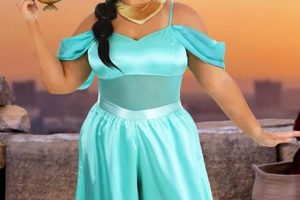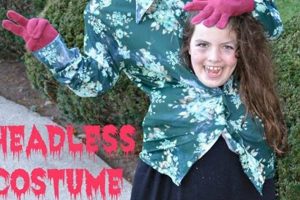Creating a character-inspired outfit based on the beloved blue, furry monster from the Pixar film Monsters, Inc. typically involves a do-it-yourself approach. This process entails assembling clothing and accessories to resemble the character James P. “Sulley” Sullivan. An example includes crafting purple spots from felt and attaching them to a blue garment to mimic Sulley’s distinctive fur pattern.
The appeal of constructing such an ensemble lies in its cost-effectiveness and potential for personalization. It allows individuals to express creativity and resourcefulness while embodying a recognizable and popular figure. Historically, handmade costumes have provided an affordable alternative to commercially produced options, fostering a sense of individual expression and craftsmanship, particularly within fan communities and at themed events.
The following sections will delve into specific techniques for replicating Sulley’s look, examining material choices, construction methods, and accessory options to aid in the creation of a convincing and memorable character representation.
Crafting a Superior Sulley-Inspired Ensemble
Achieving an authentic Sulley representation requires careful consideration of several key elements. The following tips provide guidance for constructing a recognizable and durable costume.
Tip 1: Prioritize Fabric Selection: Opt for high-quality faux fur in a shade of vibrant blue. This material forms the foundation of the costume and directly impacts its overall appearance. Avoid thin or easily matted fabrics; invest in a durable option.
Tip 2: Accurately Replicate the Spot Pattern: Purple felt is a standard choice for the spots, but ensure the color is consistent with Sulley’s design. Templates can be created from cardboard to ensure uniformity in size and shape. Securely attach the spots using fabric glue or by sewing.
Tip 3: Consider Padding for Volume: Sulley possesses a bulky physique. Strategically placed padding, constructed from batting or foam, can enhance the costume’s dimensions and create a more accurate silhouette, particularly in the torso and shoulder regions.
Tip 4: Footwear Matters: Oversized, furry shoe covers, preferably in a shade matching the body, contribute to the completeness of the ensemble. Secure the covers firmly to existing footwear to prevent slipping and maintain a cohesive look.
Tip 5: Tail Construction and Attachment: The tail requires careful design to balance realism and practicality. Consider using wire within the tail to allow for poseability. Securely attach the tail to the base of the costume using reinforced stitching.
Tip 6: Horn Replication: Mold lightweight horns from craft foam or a similar material. Pay close attention to the shape and curvature depicted in the source material. Ensure secure and comfortable attachment to a headpiece.
These guidelines emphasize attention to detail and material quality, factors crucial to a successful character representation. Implementing these suggestions can significantly elevate the authenticity and overall impact of the costume.
The subsequent section will explore potential challenges and troubleshooting strategies encountered during the costume construction process.
1. Faux Fur Selection
The selection of faux fur is paramount when undertaking the construction of a character-inspired outfit based on Sulley from Monsters, Inc. The material serves as the primary visual component and significantly influences the costume’s overall authenticity and aesthetic appeal.
- Color Accuracy
The selected faux fur must closely match the distinctive cerulean or royal blue hue of Sulley’s fur. Deviations from this color can diminish the costume’s recognizability. The materials dye saturation and vibrancy should also be considered to prevent a dull or washed-out appearance.
- Pile Length and Texture
The pile length, or the length of the individual fibers, should approximate the fur’s perceived length in the source material. Excessive length can appear cumbersome, while insufficient length may lack the desired fluffiness. The texture, whether smooth or slightly crimped, also contributes to the overall realistic effect.
- Durability and Shed Resistance
The chosen faux fur must withstand the rigors of costume wear and handling. A high-quality fabric will exhibit minimal shedding, preventing fiber loss during construction and use. Durability is also crucial for maintaining the costume’s integrity over multiple wearings.
- Cost and Availability
While quality is paramount, cost considerations are also relevant. Faux fur prices vary depending on fiber type, density, and manufacturer. Availability can also be a limiting factor, particularly for specific colors or textures. Balancing cost with desired quality is a necessary aspect of the selection process.
The interplay of color accuracy, pile characteristics, durability, and affordability makes selecting the appropriate faux fur a pivotal decision in the “sully from monsters inc costume diy” endeavor. Compromises in any of these areas can negatively impact the final result, emphasizing the importance of careful evaluation and informed decision-making.
2. Spot Pattern Accuracy
Within the context of crafting a character-inspired outfit, the precision with which the spot pattern is replicated directly influences the recognizability and overall success of the undertaking. For a “sully from monsters inc costume diy” project, the characteristic purple spots are a defining visual element. Inaccurate reproduction diminishes the costume’s resemblance to the source character, rendering it less effective. For example, improperly sized spots or an incorrect spatial arrangement can lead to misidentification or a generic, non-specific appearance. The spot pattern is, therefore, not merely a decorative addition but a crucial component for achieving a convincing likeness.
The implications of accurately replicating the spot pattern extend beyond mere aesthetics. A well-executed pattern demonstrates attention to detail and a commitment to authenticity, elevating the perceived quality and craftsmanship of the costume. In contrast, carelessly applied or poorly shaped spots can undermine the overall impression, even if other aspects of the costume are well-executed. Individuals attending costume events or participating in fan communities often scrutinize these details, and the accuracy of the spot pattern serves as a visible marker of the costume’s quality and the creator’s dedication.
Maintaining accuracy requires careful planning and execution. Templates aid in consistently producing spots of the correct size and shape. Precis
e placement, based on reference images, is essential. The method of attachment also plays a role; securely affixed spots prevent displacement or detachment, maintaining the pattern’s integrity throughout wear. Spot Pattern Accuracy, therefore, is not a trivial detail but a critical factor in determining the ultimate success of a “sully from monsters inc costume diy” endeavor.
3. Horn Construction Method
The selection and execution of the horn construction method are intrinsically linked to the success of a “sully from monsters inc costume diy” project. The horns are a readily identifiable characteristic, and their appearance significantly impacts the costume’s overall authenticity. An inadequate method can result in horns that are misshapen, structurally unsound, or uncomfortable to wear, thereby detracting from the intended representation. For example, using heavy materials like solid plaster will produce durable horns, but their weight presents a significant wearing burden. Conversely, flimsy construction, such as using only thin cardboard, yields horns prone to bending or collapsing. Therefore, the chosen horn construction method must balance visual accuracy with wearability and structural integrity.
Several practical methods are available, each presenting its own advantages and disadvantages. Craft foam, for instance, offers a lightweight and easily moldable material, allowing for detailed shaping and comfortable wear. However, it requires reinforcement to prevent deformation. Thermoplastics, like Worbla, provide greater durability and the ability to hold complex shapes, but necessitate specialized tools and skills. Paper mache represents a cost-effective option, but its susceptibility to moisture damage limits its suitability for extended use. Selecting a method depends on factors such as budget, skill level, and the desired level of realism and durability. Failure to consider these factors often results in visually unappealing or structurally unsound components, negatively affecting the finished costume.
In summary, the horn construction method is a critical determinant in the effectiveness of a “sully from monsters inc costume diy” endeavor. Balancing aesthetics, comfort, and durability necessitates careful material selection and proficient execution. Challenges arise from the need to reconcile potentially conflicting requirements, such as lightweight construction and structural stability. Understanding the nuances of different methods and their associated trade-offs is essential for achieving a convincing and wearable representation of the character.
4. Tail Attachment Security
In the context of a “sully from monsters inc costume diy” project, tail attachment security constitutes a critical engineering consideration. The tail, a prominent feature of the character’s design, is subject to significant stress during movement. An insecure attachment point results in detachment, compromising the costume’s aesthetic integrity and potentially causing disruption or embarrassment at events. This can be directly attributed to insufficient load-bearing capacity at the connection point, inadequate adhesive strength, or inappropriate stitching techniques. For example, a tail solely affixed with hot glue is likely to detach under moderate strain, whereas a tail sewn with reinforced stitching onto a robust backing material offers greater durability.
Effective tail attachment involves a multi-faceted approach. The chosen attachment method must be compatible with the materials used for both the tail itself and the costume base. A common strategy involves creating a sturdy fabric loop on the tail and securing it to a reinforced section of the costume using heavy-duty stitching and potentially incorporating additional support structures, such as internal boning or interfacing. The placement of the attachment point is also crucial; positioning the tail near a seam or structural element of the costume distributes stress more effectively than attaching it to a single layer of fabric. Furthermore, the size and weight of the tail necessitate careful consideration. Larger, heavier tails require more robust attachment methods to prevent premature failure. Examples of secure tail attachments include using industrial-strength Velcro in conjunction with stitching for easy removal and reattachment or creating a harness-like system to distribute the tail’s weight evenly across the wearer’s back.
Achieving adequate tail attachment security presents a recurring challenge in “sully from monsters inc costume diy” endeavors. Overcoming this challenge requires a blend of structural design principles, material science knowledge, and practical sewing skills. A secure and well-integrated tail not only enhances the costume’s visual appeal but also contributes to its longevity and wearability, ultimately increasing the wearer’s satisfaction and the overall success of the project. The integration of robust attachment mechanisms prevents potential wardrobe malfunctions and preserves the intended character representation.
5. Padding and Volume
The incorporation of strategic padding to achieve appropriate volume is fundamental to accurately replicating the character’s substantial physique in a “sully from monsters inc costume diy” project. Sulley, from Monsters, Inc., possesses a distinctly large and rounded body shape, deviating significantly from the typical human form. Therefore, simply wearing a blue, furry garment will not suffice in creating a convincing representation; the addition of padding is essential to achieve the correct proportions and overall visual impact.
- Torso Proportionality
Replicating Sulley’s considerable torso volume requires strategic padding placement around the chest, abdomen, and back areas. The aim is to broaden the wearer’s silhouette and create a rounded, barrel-like shape consistent with the character’s appearance. Insufficient padding in this area results in a disproportionately slender physique, undermining the costume’s authenticity. Conversely, excessive padding can create an unnatural or unwieldy appearance. The accurate distribution and shaping of the padding are paramount to achieving a balanced and believable result.
- Limb Augmentation
Sulley’s limbs, particularly his arms and legs, exhibit significant thickness and bulk. Achieving this effect necessitates the addition of padding to these areas. This is typically accomplished through the use of padded sleeves and leggings, carefully shaped to mimic the character’s limb proportions. As with the torso, achieving the correct balance is crucial; overly bulky limbs can impede movement and create an unrealistic appearance, while insufficient padding fails to capture the character’s distinct physique.
- Shoulder Definition
The broad shoulders are another defining characteristic of Sulley’s physical form. Enhancing shoulder width through the strategic placement of shoulder pads is essential for replicating the character’s imposing stature. The shape and positioning of the shoulder pads must be carefully considered to avoid creating an unnatural or exaggerated appearance. The goal is to create a smooth,
gradual transition from the neck to the shoulders, mimicking the character’s powerful physique. - Material Selection for Padding
The choice of padding material significantly impacts the comfort, appearance, and overall success of the costume. Lightweight, breathable materials such as batting, foam, or quilt filling are commonly employed. These materials allow for flexibility and prevent overheating, ensuring wearer comfort. The density and texture of the padding material also influence the final appearance; denser materials create a firmer, more defined shape, while softer materials provide a more rounded and pliable effect. The selection of padding material should be based on the desired level of realism, comfort, and ease of construction.
The strategic integration of padding, considering torso proportionality, limb augmentation, shoulder definition, and material selection, is indispensable for a successful “sully from monsters inc costume diy” endeavor. These facets, when carefully executed, contribute to a convincing and visually impactful representation of the character, effectively capturing the essence of Sulley’s distinct physical form.
6. Footwear Coverage Detail
Footwear coverage detail, concerning a Sulley-inspired outfit project, represents a significant aspect of character representation. The complete encasement of the wearer’s feet within appropriate coverings directly contributes to the illusion of embodying the character, James P. “Sulley” Sullivan, a large, furry monster. A failure to adequately address footwear diminishes the overall effect, undermining the time and effort invested in other costume components.
- Material Consistency
Maintaining material consistency between the primary costume body and the footwear is critical. Ideally, the footwear coverings should be constructed from the same faux fur used for the body, ensuring a uniform texture and color. A mismatch in material detracts from the cohesiveness of the ensemble and disrupts the visual flow from head to toe. An example of successful material consistency includes custom-made shoe covers fashioned from surplus faux fur from the main body construction, seamlessly blending with the overall costume aesthetic. Conversely, mismatched materials can appear disjointed and amateurish.
- Shape and Proportion
Accurate representation necessitates careful consideration of the shape and proportion of the footwear coverings. Sulley’s feet are large and somewhat exaggerated; therefore, the coverings should reflect this characteristic. Oversized shoe covers, perhaps with a rounded or slightly elongated shape, effectively convey the character’s foot morphology. Proportions must be balanced to avoid appearing comical or disproportionate to the wearer’s body size. For instance, overly large shoe covers impede movement and disrupt the costume’s overall balance, whereas undersized coverings fail to capture the character’s essence.
- Secure Attachment
The method of attaching the footwear coverings to the wearer’s existing shoes or feet directly impacts both safety and visual appeal. The coverings must be securely fastened to prevent slippage or detachment during movement. Elastic straps, zippers, or Velcro closures provide secure and adjustable attachment options. Internal supports or frames maintain the shape of the coverings and prevent them from collapsing or deforming. Inadequate attachment mechanisms result in unstable or unsightly footwear, detracting from the costume’s overall impression. A secure and well-integrated attachment enhances the wearer’s comfort and confidence while maintaining the costume’s visual integrity.
- Detailing and Embellishment
The addition of details and embellishments to the footwear coverings further enhances the character representation. Claws, scales, or other textural elements can be incorporated to mimic Sulley’s monstrous feet. These details should be carefully executed and proportionally scaled to maintain visual consistency. For example, faux claws made from foam or felt can be attached to the shoe covers, adding a touch of realism. Overly elaborate or poorly executed details, however, detract from the costume’s overall effect. Subtle and well-integrated embellishments contribute to a more convincing and visually engaging representation.
The convergence of material consistency, proportional accuracy, secure attachment, and carefully considered detailing on footwear coverings elevates the overall success of a Sulley-inspired outfit endeavor. These seemingly minor details collectively contribute to a convincing transformation, effectively embodying the character and enhancing the overall impact of the costume. A deliberate focus on footwear detail underscores a commitment to authenticity, resulting in a more polished and immersive character representation.
Frequently Asked Questions
This section addresses common inquiries and challenges encountered during the creation of a character-inspired outfit based on Sulley from Monsters, Inc.
Question 1: What is the optimal type of faux fur for replicating Sulley’s fur texture?
The recommended choice is a long-pile faux fur with a slight crimp or wave to mimic the character’s fluffy appearance. The color should closely match Sulley’s distinct cerulean or royal blue hue. A durable, high-quality fabric minimizes shedding and ensures longevity.
Question 2: How can the accuracy of the purple spot pattern be ensured?
Templates constructed from cardboard or sturdy plastic aid in creating uniformly sized and shaped spots. Reference images should be consulted to determine the correct placement and spacing. Secure attachment via sewing or fabric adhesive is critical to prevent detachment during wear.
Question 3: What materials are suitable for constructing Sulley’s horns?
Lightweight materials, such as craft foam or thermoplastics, are preferred. Craft foam is easily moldable and comfortable, while thermoplastics offer greater durability. Regardless of the material chosen, the horns should be securely attached to a headband or headpiece for comfortable wear.
Question 4: What is the most secure method for attaching the tail to the costume?
A robust attachment point is essential. This involves creating a reinforced loop or harness system on the tail and securing it to a sturdy section of the costume using heavy-duty stitching and potentially internal supports. The weight and size of the tail must be considered to ensure the attachment can withstand stress during movement.
Question 5: How can the appropriate volume and proportions be achieved for Sulley’s body?
Strategic padding is necessary to replicate Sulley’s bulky physique. Padding should be placed around the chest, abdomen, back, arms, and legs to create a rounded, barrel-like shape. The padding material should be lightweight and breathable to ensure wearer comfort.
Question 6: How can complete and cohesive footwear coverage be achieved?
Custom-made shoe covers constructed from the same faux fur as the main body of the costume provide a seamless and consistent appearance. The covers should be oversized and shaped to mimic Sulley’s large feet. Secure attachment to existing footwear is crucial for stability and safety.
These frequently asked questions highlight critical aspects of replicating a character-inspired outfit. C
areful attention to material selection, construction techniques, and attachment methods contributes significantly to the success of the endeavor.
The next section will delve into potential variations and enhancements to further personalize the costume.
Sulley from Monsters, Inc. Costume DIY: A Comprehensive Overview
This exploration has detailed essential elements for the successful fabrication of a Sulley-inspired ensemble. Key aspects include meticulous faux fur selection, precise replication of the spot pattern, robust horn construction, secure tail attachment, strategic padding implementation, and comprehensive footwear coverage. Mastering these elements directly impacts the costume’s authenticity and overall effectiveness in representing the character.
Effective costume construction demands diligence and a commitment to accuracy. By focusing on the outlined techniques and addressing potential challenges, creators can realize a convincing and memorable representation. The pursuit of detailed craftsmanship ensures a successful transformation, paying homage to the source material while celebrating individual creativity. Continued exploration of advanced methods and material innovations may further elevate the standard of DIY character representation.







![DIY Care Bear Costume: Easy & Adorable [Guide] The DIY Hub: Creative Crafts, Repairs & Life Hacks DIY Care Bear Costume: Easy & Adorable [Guide] | The DIY Hub: Creative Crafts, Repairs & Life Hacks](https://craftingdiycenter.com/wp-content/uploads/2025/07/th-7305-300x200.jpg)